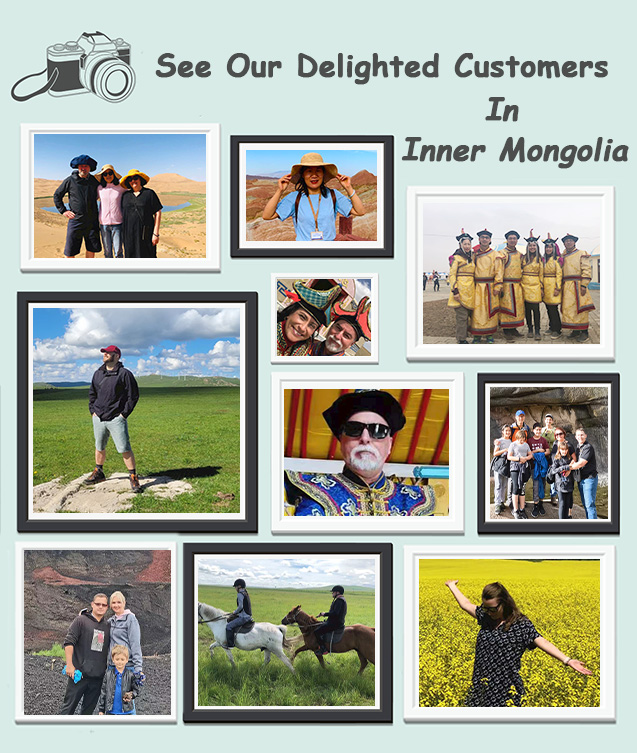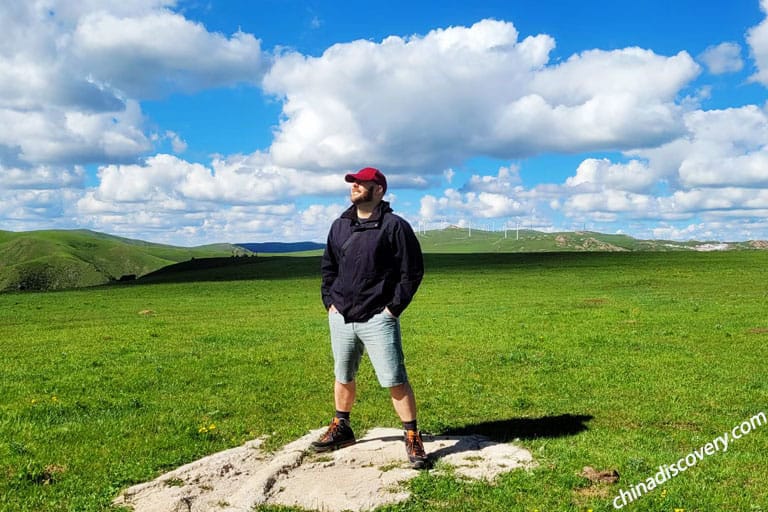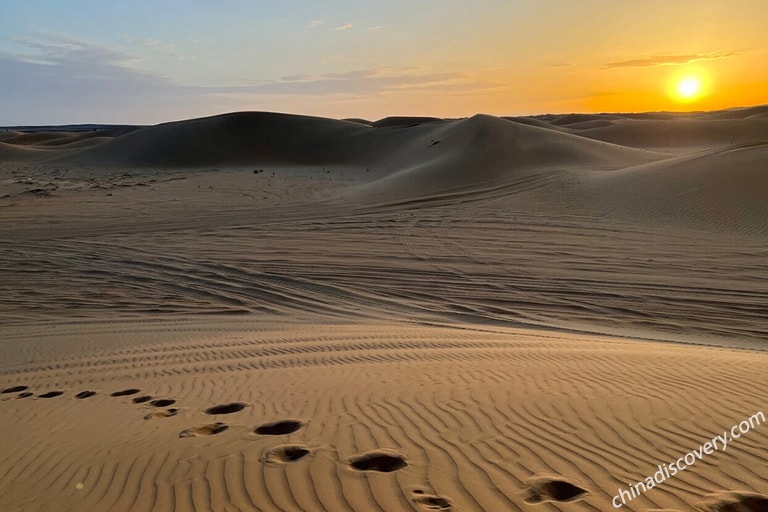Why Visit Inner Mongolia Museum?
Located in the center of Hohhot, the capital of the autonomous region, the Inner Mongolia Museum (内蒙古博物院) is the only comprehensive museum with a provincial level and the earliest museum established in ethnic minority areas in China. The main building area of Inner Mongolia Museum is more than 50,000 square meters, with unique shape and advanced equipment and technology. It is composed of exhibition hall area, cultural relic storehouse area, visitor service area, business and research area and multi-function hall, etc. It is also one of the landmark buildings of the autonomous region.
The Inner Mongolia Museum has a collection of more than 150,000 pieces, featuring paleontological fossils, Khitan cultural relics and Mongolian cultural relics, tracing the historical process of Inner Mongolia from prehistoric times, the Bronze Age, the Warring States to the Wei and Jin, the Liao and Jin, the Mongolian-Yuan to the Ming and Qing Dynasties, as well as modern times. It is an "encyclopedia" that concentrates on the history of ecological changes and grassland civilization in northern China over hundreds of millions of years. It is also a symbol of the level of economic and social development and civilization of Inner Mongolia.
- 4 Days Inner Mongolia Grassland & Genghis Khan Culture Tour
- 5 Days Classic Inner Mongolia Tour
- 6 Days Inner Mongolia Bests Discovery Tour
Best Inner Mongolia Culture Tours:
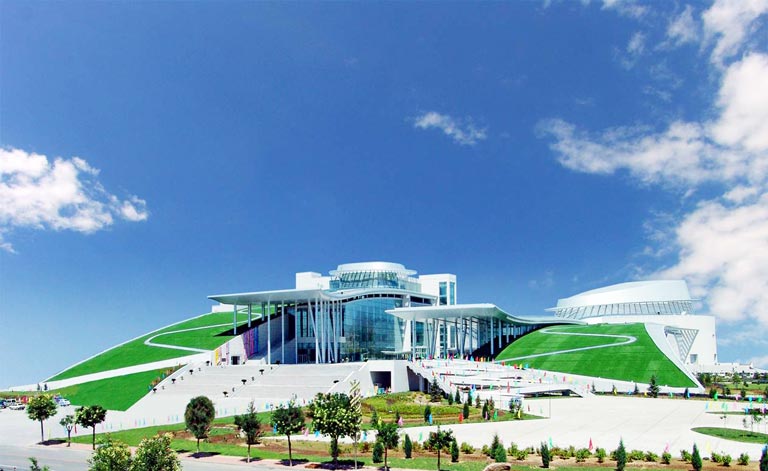 Outlook of Inner Mongolia Museum
Outlook of Inner Mongolia Museum
 Treasure of Inner Mongolia Museum
Treasure of Inner Mongolia Museum
Exhibition Halls in Inner Mongolia Museum
Based on the advantages of abundant paleontological fossils, living organisms, historical relics and ethnic relics, etc. of the autonomous region, the Inner Mongolia Museum takes the "Grassland Culture" as the theme to run through all basic and thematic displays, forming a series of exhibitions of Grassland Culture, which are distributed in 3 floors of the museum, consisting of overall 14 exhibition halls.
The four basic exhibition halls on the 2nd floor, "Ancient World", "Magnificent Plateau", "Underground Treasure" and "Flying Shenzhou Spacecraft", introduce the place where the grassland culture was born. The scenes of the exhibition halls are blended with cultural relics perfectly. On the 3rd floor, the four basic exhibition halls of "Glory Grassland", "The Proud Son of Heaven", "Grassland Charm" and "Flames of War on the Grassland" show the longitudinal development lines of the grassland culture from ancient times to modern times in Plate beaded form, which are concise and vivid, easy to understand. The six thematic displays on the 4th floor, "Grassland Sunrise", "Wind Ritter", "Grassland Costumes", "Sky Melodies", "Gorgeous Chapters of Grassland" and "Ancient Road Treasures", present six wonderful features of Grassland culture in a bright and focused way, which are fresh and solemn and enjoy both refined and popular tastes.
The display is multi-dimensional, multi-angle, crisscross, point and surface combination, from macro to micro system showing the complete image of Inner Mongolia with distinctive personality, which is really fascinating.
Exhibition Halls on the 2nd Floor
Ancient World: The exhibition hall mainly displays the natural paleontological fossils found in Inner Mongolia, showing the great changes of the ancient ecological environment of Inner Mongolia which rose and fell from 3 billion years ago to 10,000 years ago, especially highlighting the fossil specimens of Mesozoic dinosaurs, Tertiary and Quaternary mammals.
Magnificent Plateau: The exhibition hall mainly displays the specimens of nowadays existing living creatures in Inner Mongolia. With the typical environmental organisms in the eastern forest, the central grassland and the western Gobi Desert as the shining points, it leads the audience into the unique natural ecological world of Inner Mongolia.
Underground Treasure: Inner Mongolia geological and mineral specimens display, including all kinds of precious metal minerals, nonferrous metal minerals, nonmetallic minerals, energy mineral resources and building materials in Inner Mongolia, showing the rich geological and mineral resources of Inner Mongolia.
Flying Shenzhou Spacecraft: The large-scale exhibition of China's space science and technology based on Inner Mongolia will display the history of the aerospace industry of the Republic of China, the achievements of the space industry and the great contribution of the people of Inner Mongolia to China's space industry, and stimulate the emotions of people to explore space and carry forward the open humanistic spirit of the grassland.
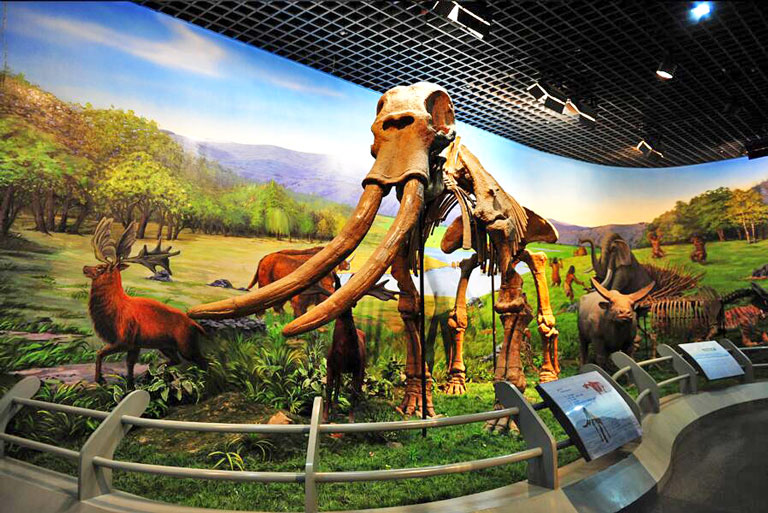 Ancient World
Ancient World
 Flying Shenzhou Spacecraft
Flying Shenzhou Spacecraft
Exhibition Halls on the 3rd Floor
Glory Grassland: The exhibition of ancient ethnic history of Inner Mongolia displays the fine cultural relics of ancient peoples of the Donghu, Huns, Xianbei, Turkic, Khitan, etc. It highlights the history of the Hongshan culture in the Neolithic Age and the Liao culture, and tells the origin, formation, development and brilliance of the grassland civilization.
The Proud Son of Heaven: The exhibition of the general history of the ancient Mongolians, with Genghis Khan and the Yuan Dynasty as the highlights, shows the wisdom, brilliant creation and magnificent history of the Mongolians from the origin of the Mongolians to the Yuan Dynasty to the Ming and Qing Dynasties for nearly a thousand years, which is one of the most eye-catching featured exhibits in the world.
Grassland Charm: The exhibition of modern ethnic customs in Inner Mongolia displays the production and life, culture and art, customs and rituals, religious beliefs and other customs of the Mongolian, Daur, Ewenki, Oroqen, Manchu, Hui and Korean, etc. living in Inner Mongolia in recent hundreds of years, actively carrying forward the fine cultural traditions of the ethnic groups.
Flames of War on the Grassland: The history of Modern Revolutionary Struggle in Inner Mongolia is on display, exhibiting the social conditions and revolutionary relics of Inner Mongolia from May 4th Movement on 1919 to 1949 when the People's Republic of China was founded.
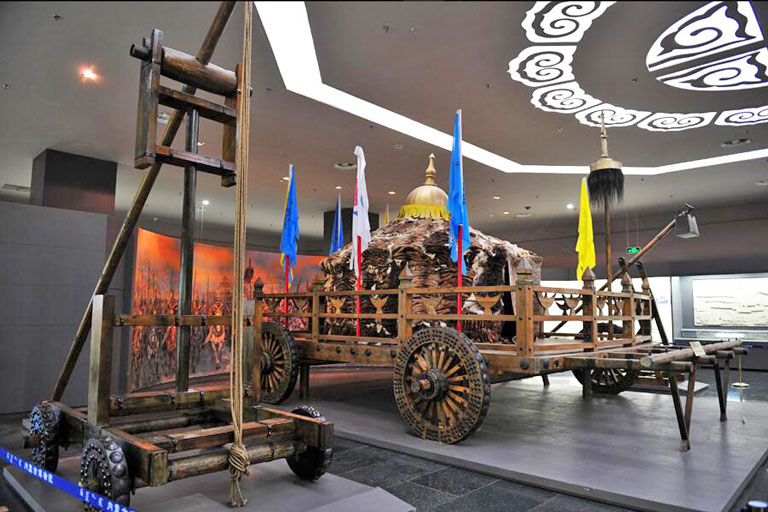 The Proud Son of Heaven
The Proud Son of Heaven
 Grassland Charm - Ewenki Minority
Grassland Charm - Ewenki Minority
Exhibition Halls on the 4th Floor
Grassland Sunrise: Monographic display of Neolithic Cultural Relics in Inner Mongolia shows the farming, hunting, pottery making, jade carving, living, diet, clothing, marriage and childbearing, funeral, culture, religion and social organization, etc. of ancient Chinese people in the north grassland in the neolithic age. It shows the indelible contribution of grassland civilization to the development of Chinese civilization.
Wind Ritter: The special display of ancient pommel horse relics in Inner Mongolia shows the horse breed, horse harness, horse herding and domestication, the influence of horse on the economy and culture of the central plains, as well as the cavalry weapons of the past dynasties, fully embodies the wisdom and creation of the northern grassland nation and the heroic spirit of the horseback nation.
Grassland Costumes: It’s a special display of ancient costume relics in Inner Mongolia. The method of leaping and stringing beads is used to reflect the unique costume styles of the northern steppe and forest nationalities and to show the aesthetic value orientation of the northern nomadic peoples in ancient China.
Sky Melodies: The display of Inner Mongolia ancient and modern song and dance art shows thousands of years of endless singing and dancing traditions in the northern grassland, a profound cultural background and unique national artistic creativity.
Gorgeous Chapters of Grassland: It’s an exhibit of ancient culture and art relics of Inner Mongolia, displaying cultural relics such as rock paintings, steles and stone carvings of the northern steppe nationalities over thousands of years from the Neolithic Age to the Qing Dynasty, reflecting the unique style in the ideological and cultural creation of the northern steppe nationalities.
Ancient Road Treasures: Inner Mongolia Ancient Grassland Silk Road Cultural Relics Display, showing the fine cultural relics from the Central Plains to the grasslands, from the west to the grasslands, and influenced by the eastern and western culture from the Warring States Period to the Qing Dynasty. It reflects the open consciousness of the grassland people in northern China and their important role in the communication between Eastern and Western culture.
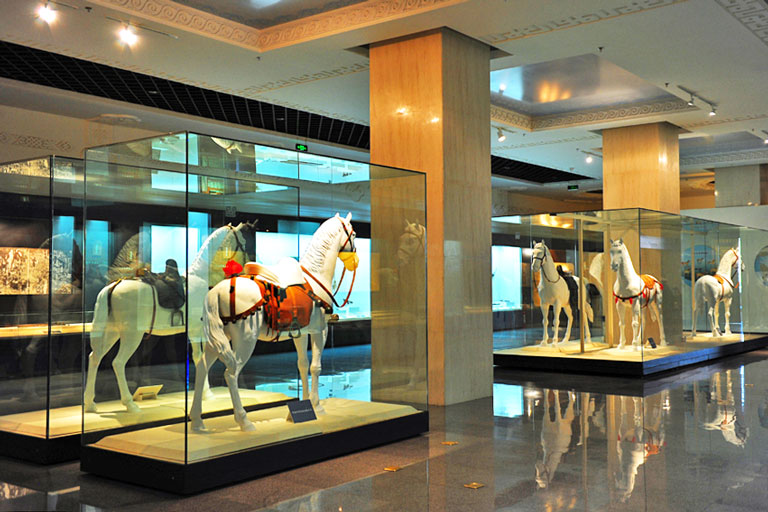 Wind Ritter
Wind Ritter
 Sky Melodies
Sky Melodies
 Gorgeous Chapters of Grassland
Gorgeous Chapters of Grassland
Collections in Inner Mongolia Museum
The Inner Mongolia Museum has a total collection of more than 150,000 cultural relics, among which there are more than 5,600 pieces (sets) of valuable cultural relics and over 650 Class A heritages, with paleontological fossils, Khitan historical relics and Mongolian cultural relics as the highlights.
Representatives of Historical Heritage
The Golden Crown of Huns’ King (匈奴王金冠): Also known as the eagle crown, the crown is embossed with four animal patterns of tiger, wolf, sheep and horse, and the top is decorated with eagle made of gold and turquoise, representing the highest level of precious metal technology of the northern ethnic groups in the Warring States Period.
Bird-shaped Double Series Painted Pottery Pot (鸟形双系彩绘陶壶): Made in the Neolithic Age, 36 cm high, 32 cm belly diameter, 11 cm bottom diameter. The pottery is made of sand and ash, shaping like a starving nestling raises its head and opens its mouth craving for food. It is a typical artifact of Xiaoheyan culture.
 The Golden Crown of Huns’ King
The Golden Crown of Huns’ King
Representatives of Ethnic Heritage
Mantra Board of the Altar of the Bodhisattva: Made in the Qing Dynasty, the wood is 66.5 centimeters long, 66.5 centimeters wide and 3 centimeters thick. It is a first-class cultural relic in the Inner Mongolia Museum. The Mantra Board engraved with the figure of Mantra Wheel of the Tripitaka Sutra.
The Bird-feather Styled Shaman Costume: The costume is made of silk and satin in the Qing Dynasty. Length 145 cm, two sleeves width 177 cm, it’s a cultural relic collected from Hulunbuir city. This double-lapel shaman costume shows the Mongolian shamanism belief with bird worship as a prominent feature.
 The Bird-feather Styled Shaman Costume
The Bird-feather Styled Shaman Costume
Representatives of Paleontological Fossil
A Nest of Prolate Dinosaur Eggs Fossil: The fossil dates from the Late Cretaceous and was found in Bayan Mandahu, Urad Back Banner, Bayannur League, Inner Mongolia.
The Whole Skeleton of the Woolly Rhinoceros: With 3.5 m long, 1.7 m high, the fossil is dated from the late Pleistocene. It was discovered in Salawusu, Wushen Banner, Ordos City, Inner Mongolia in 1964.
 A Nest of Prolate Dinosaur Eggs Fossil
A Nest of Prolate Dinosaur Eggs Fossil
How to Get to Inner Mongolia Museum | Inner Mongolia Museum Location
- Inner Mongolia Museum Address: No.27 Xinhua East Street, Xincheng District, Hohhot (呼和浩特新城区新华东街27号)
Located in the downtown area of Hohhot City, the Inner Mongolia Museum can be easily reached by car/taxi, metro and public bus from Hohhot airport, railway stations in Hohhot (Hohhot Railway Station and Hohhot East Railway Station) and Hohhot city center (Xinhua Square). The Inner Mongolia Museum is about 7 km away from Hohhot city center, which takes about 30 minutes by metro, less than 20 minutes by taxi/car and 40 minutes by bike.
Hohhot Airport to Inner Mongolia Museum
Hohhot Baita International Airport (呼和浩特白塔机场) is about 10 km away from the Inner Mongolia Museum. You may get there by taking Metro Line 1 and get off at Municipal Government Station and then walk 1 km (about 15 minutes) to reach the entrance gate of Inner Mongolia Museum. You can also take Airport Shuttle Bus Line 1, departure at Inner Mongolia Museum Station, which will take about 40 minutes. It takes less than 30 minutes to transfer from Hohhot Airport to Inner Mongolia Museum by car/taxi.
Hohhot Train Stations to Inner Mongolia Museum
There are 2 frequently used railway stations in Hohhot, namely Hohhot Railway Station and Hohhot East Railway Station.
Hohhot East Railway Station to Inner Mongolia Museum: The distance between Hohhot East Railway Station and Inner Mongolia Museum is less than 3 km, which only takes 10 minutes by car/taxi. You may also take local public buses or metro (Line 1) to get there.
Hohhot Railway Station to Inner Mongolia Museum: Hohhot Railway Station is about 7 km away from Inner Mongolia Museum, which takes 20~30 minutes by car/taxi. For independent travelers, you may also transfer between two places by metro transfer (you may transfer to Line 1 at Xinhua Square Station) or public bus.
Check more about How to Get to & Get around Hohhot >>
Popular Hohhot Tours:
☛ 3 Days Best Hohhot Grassland Tour with Huitengxile Landscape
 Hohhot East Railway Station
Hohhot East Railway Station
Attractions near Inner Mongolia Museum
Dazhao Temple
- Address: Dazhao Front Street, Yuquan District, Hohhot (呼和浩特市玉泉区大召前街)
- Distance to Dazhao Temple: 9 km, which takes about 30 minutes by car/taxi.
Dazhao Temple (大召寺) was first built during the reign of Longqing in the Ming Dynasty (1567 ~ 1572). It’s also one of the most famous Gelugpa temples in Inner Mongolia. The stately and gorgeous buildings in the temple is mainly Han style, complemented by the architectural style of the Mongolian. Besides, there are also many precious cultural relics and works of art (Sliver Buddha, Dragon Carving and Murals), etc. Check more details about Dazhao Temple >>
 Dazhao Temple
Dazhao Temple
Five-pagoda Temple
- Address: Xiaozhao Front Street, Yuquan District, Hohhot (呼和浩特市玉泉区小召前街)
- Distance to Dazhao Temple: about 1 km, which takes about 10 minutes by car and 20 minutes on foot.
The Five-pagoda Temple (五塔寺) was first built in the fifth year of Emperor Yongzheng's reign in the Qing Dynasty. It’s a Buddhist pagoda building with 5 exquisite sarira pagodas built on the Vajrasana, known as the Five Pagoda. It is the landmark building of Hohhot.
 Five-pagoda Temple
Five-pagoda Temple
Zhaojun Tomb
- Address: South Zhaojun Road, Yuquan District, Hohhot (呼和浩特市玉泉区南昭君路6公里处)
- Distance to Dazhao Temple: about 20 km, which takes about 40~50 minutes by car/taxi.
Zhaojun Tomb (昭君墓) is a large and man-made earthen mound, which is 33 meters high. It is the resting place of Han princess, also one of the four most beautiful ladies in ancient China, who voluntarily married a nomad Hun chief to secure peace. She is attributed with the ability to perform miracles.
Check all Attractions & Things to Do in Hohhhot >>
☛ 4 Days In-depth Hohhot Xilamuren Tour with Grassland Activities
.jpg) Zhaojun Tomb
Zhaojun Tomb
How to Plan a Hohhot Tour
Best Time to Visit Hohhot: May ~ October, especially in June, July, August and September…
How to Get There: Flights from Beijing (1.5h), Shanghai (2.5h), Harbin (4.5h), Guangzhou (3.5h), etc. and bullet train from Beijing (2.5~3h), Datong (2.5h), etc.
Usually, visitors spend 2~3 days to visit Hohhot, including one day to explore the highlights in the city, like Dazhao Temple and Inner Mongolia Museum, and 1~2 days to have fun at the nearby grasslands, like Huitengxile Grassland or Xilamuren Grassland.
☛ 3 Days Best Hohhot Grassland Tour with Huitengxile Landscape
☛ 2 Days Huitengxile Grassland Tour from Beijing by Bullet Train
If you have 1~2 days more day, you are highly suggested to add Kubuqi Desert into your trip. Kubuqi Desert is one of the best deserts in China. You can enjoy colorful activities there, like riding camels, hiking, playing sands, etc.
☛ 5 Days Classic Inner Mongolia Tour (Hohhot / Huitengxile Grassland / Kubuqi Desert / Ordos)
Feel not enough? You can spend one day more to Ordos to explore the legend of the great Mongolian conqueror Genghis Khan, 1~2 days more to Xilingol to discover the UNESCO World Cultural Heritage Site - Site of Xanadu, 3~5 days more to Hulunbuir to meet the most beautiful grassland in China and visit fabulous wetlands , forests and Russian Nationality Villages. Have your preferences about Hohhot and Inner Mongolia? Please feel free to tell us your likes and let our experienced travel consultant customize a tour for you!
☛ 6 Days Inner Mongolia Bests Discovery Tour (Hohhot / Ulanqab / Huitengxile Grassland / Baotou / Kubuqi Desert / Ordos)
☛ 5 Days Best Hulunbuir Tour with Grassland Exploration (Hulunbuir)
☛ 6 Days Inner Mongolia Best Desert & Grassland Tour (Hohhot / Baotou / Kubuqi Desert / Hulunbuir)
Travel Hohhot with China Discovery
Hohhot and Inner Mongolia differ a lot with the classic China you know. And it is not an easy job to arrange the daily flight, train and car travel at this relatively vast land. Therefore, travel with a professional travel agency is usually the best way to visit there. We China Discovery know Hohhot and Inner Mongolia a lot and we are experienced in organizing tours to this region. If you need any help, please feel free to contact us! Private cars, one-to-one guide and travel consultant… Everything is only for you and your group or family! The tour is customized by your interest, budget, plan and every special need!
 Local Private Transfer Service
Local Private Transfer Service
Hohhot Travel Guide
- Popular Hohhot Tours
- Hohhot Travel Guide
- Top Attractions
- Things to Do
- Huitengxile Grassland
- Xilamuren Grassland
- Dazhao Temple
- Get to Hohhot
- Hohhot Baita International Airport
- Beijing to Hohhot
- Hohhot to Baotou
- Hohhot to Ordos
- Weather & Best Time
- Hohhot Where to Stay
- Hohhot Maps
- Hohhot Tour Plan
More about Inner Mongolia Travel Guide
- Popular Inner Mongolia Tours
- Inner Mongolia Travel Guide
- Top Cities & Destinations
- Hot Attractions
- Things to Do
- Famous Grasslands
- Top Deserts
- Transportation
- Weather & Best Time
- Hotels & Where to Stay
- Maps
- Photos & Landscpaes
- Travel Tips
- Foods
- Naadam Festival
- Horse Riding
- Mongolian Yurts
- Inner Mongolia Tour Plan
Recommended Hohhot Tours
Top 3 Hohhot tours chosen by most customers to explore Hohhot in the best way. Check the detailed itinerary, or tailor your own trip now with us.

5 Days Classic Inner Mongolia Tour
Hohhot / Huitengxile Grassland / Yemingsha of Kubuqi Desert / Hohhot

6 Days Inner Mongolia Bests Discovery Tour
Hohhot / Ulanqab / Huitengxile Grassland / Hohhot / Baotou / Yemingsha of Kubuqi Desert / Ordos

3 Days Best Hohhot Grassland Tour with Huitengxile Landscape
Hohhot / Huitengxile Grassland / Hohhot
Start planning your tailor-made holiday to China by contacting one of our specialists. Once inquired, you’ll get a response within 0.5~23.5 hours.
Customize a TripHave a question? Get answers from our travel experts or guests
- Your Question:
- Your Name:
- Your Email:
- Submit


























